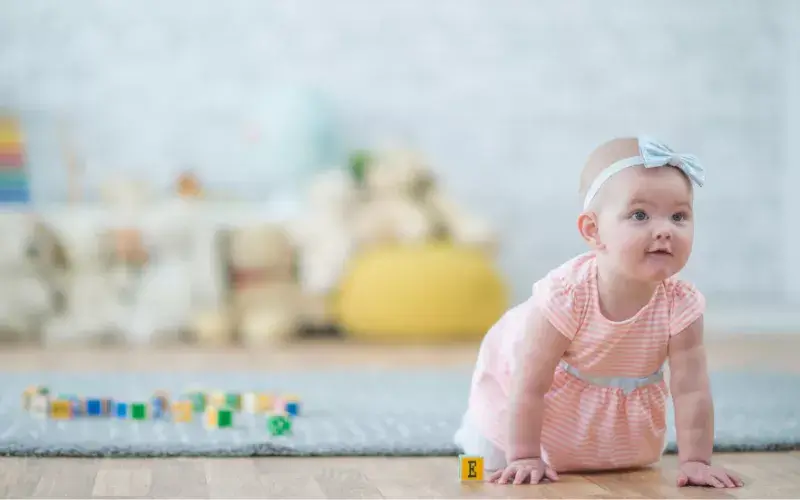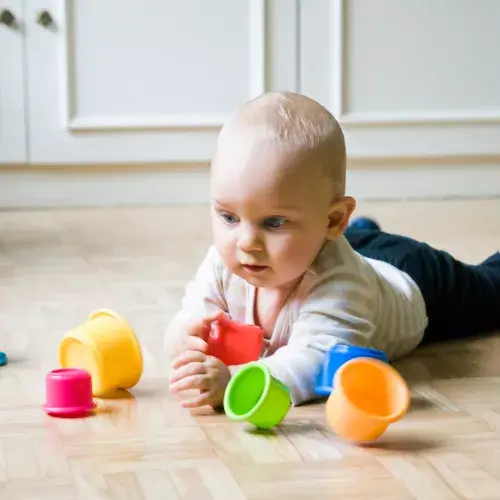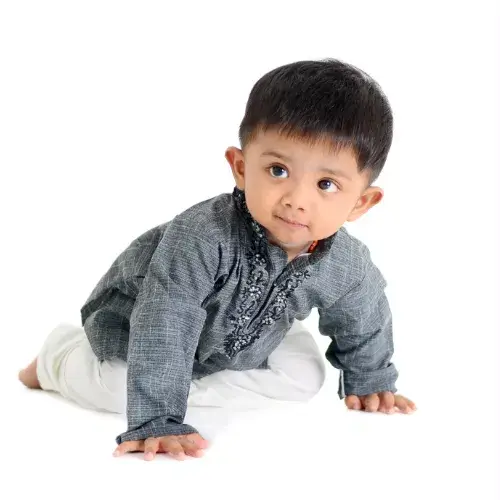
How old is baby crawling?
Are you wondering at what age your baby should start crawling and if this stage is mandatory for his development? Confused about what to do when you notice the signs of the onset of this phase? Rêves de Libellule answers all your questions.

Baby crawling: what timeline?
During their growth, your child goes through several important phases! One of them is the ramp.
While it is important to keep in mind that every child is unique, babies tend to start to crawl when they are between 7 and 9 months old, before they can walk around 11-18 months old.
If this is not the case, do not don't panic?!
Some little ones don't go through this phase and climb directly onto furniture and walls to take their first steps. It all depends on their rhythm...
Theoretically, a baby can crawl as soon as he manages to lean on a single hemibody, i.e. the right half or left of his body.
In the beginning, your child will begin by observing everything around him. Then he will want to straighten up by pushing on his arms. At some point, he will tend to back up, but when he hits a wall, for example, he will acquire the reflex of wanting to push forward and thus move forward.
Crawling allows the baby to discover the world around him while discovering himself. His visual field is widened, his curiosity is stimulated and his motor skills are developed. Over time, your child will manage to find a balance allowing him to activate his archaic reflexes.
Signs that your baby is ready to crawl
Before your little one begins to crawl, you will notice several signs in his motor skills. This phase generally follows that of the tummy/back turn, an essential stage in motor development which is acquired around the age of 6/7 months.
Here are some signs that will help you to know that your baby is finally ready to crawl:
- He is wriggling more than usual.
- He prefers the position on his stomach rather than on his back.
- He tends to touch his feet when lying down.
- When he is on his stomach, he often raises his chest and turns his head to observe his surroundings .
How to help your baby crawl?

When you see that your child is finally ready to crawl, there are lots of fun games to help develop their motor skills:
- Move their favorite toy a little further away to encourage them to go get him
- Get down on the ground and pretend to want to chase him, he will naturally tend to escape
- Offer him some fun games You can put several objects on the ground (bubble wrap, fabric, foam packaging, etc.), your baby's curiosity will make him want to discover the different textures and thus crawl towards the objects.
Make sure, however, that you secure your home or the space your baby is in when he is crawling. This will prevent him from getting into trouble or hurting himself when you are not watching him (we advise you to always keep an eye on him to avoid surprises).
What are the possible positions?
Every baby has their own way of crawling. Here are the 6 different techniques observed in the little ones:
The classic position
Also called bilateral crawling, this quadrupedal movement consists of moving by alternating the movement of the arm with that of the opposite leg. Thus, baby gradually develops his motor skills and the two hemispheres of his brain in a harmonious way.
The sitting position
When his muscles become more mature , your child tends to favor the seated position, in a natural way. It moves by sliding; his arms allow him to project himself forward while his buttocks remain glued to the ground.


The crab technique
To propel his body forward, your baby will be inclined to bend the knee of one leg and keep the other straight . We often talk about homolateral crawling since the child only moves one side of his body.
Reverse crawling
This can sometimes surprise, but several babies move backwards. There is nothing to worry about… The main thing is that they acquire reflexes that will help them grow. During this phase, do not hesitate to ensure that your child's feet meet a wall or a solid obstacle on which they can lean. This will allow them to develop several motor skills such as straightening their pelvis.
The bear crawl

This technique consists of walking on all fours, keeping arms and legs straight, like a bear. Your baby begins by moving their arms forward and then their legs through a diametrically opposed motion, so as to synchronize the right arm with the left leg and vice versa. The bear's walk helps to strengthen contralateral coordination.

The commando
The baby lies on his stomach and begins to crawl using only his arms. Moving with the body on the ground allows him not only to develop the muscles of his neck, but also those of his back. We often speak of the crawling reflex, in reference to the mode of movement of reptiles.


